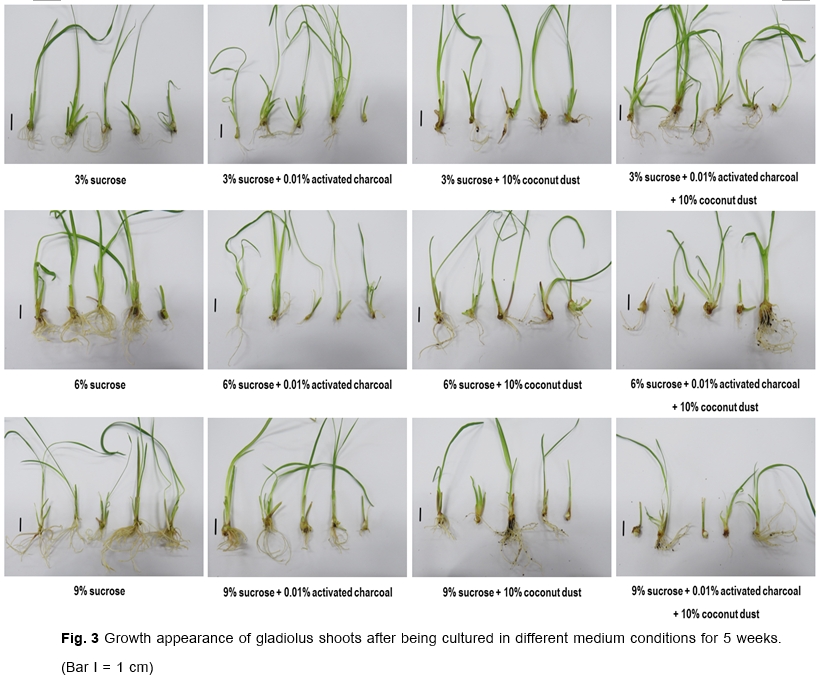The effects of sucrose, activated charcoal, and coconut dust on in vitro corm induction of Gladiolus hybrida under aseptic technique
Keywords:
Sucrose, Activated charcoal, Coconut dust, Gladiolus hybridaAbstract
This study aimed to investigate the effect of sucrose concentrations: of 3%, 6%, and 9% together with or without two different supplementary matters: activated charcoal (0.01%) and coconut dust (10%) on in vitro growth and corm induction of Gladiolus hybrida when cultured for 5 weeks. The objective was to investigate the optimal culture media for corm production in long-term culture. The results showed that shoots grown on MS medium with the addition of 10% coconut dust at any sucrose concentrations had a high percentage of corm induction, ranging from 72 to 88. The treatment of 6% sucrose supplemented with 0.01% activated charcoal and 10% coconut dust yielded the highest corm induction percentage (88%) after being cultured for 5 months. Therefore, the optimum medium for corm induction of Gladiolus hybrida was MS medium supplemented with 6% sucrose, 0.01% activated charcoal, and 10% coconut dust.
References
Shillo R, Halevy AH. The effect of various environmental factors on flowering of gladiolus. III. Temperature and moisture. Sci Hortic. 1976;4(2):147-155. https://doi.org/10.1016/S0304-4238(76)80006-4.
Surapornpiboon P. Effects of plant growth regulators on germination and growth of gladiolus var. Novalux. In 18. Annual Conference of Rajamangala Institute of Technology, Pathum Thani (Thailand), 15-17 Feb 2001. p. 82-83.
Wahocho NA, Miano TF, Leghari MH. Propagation of Gladiolus corms and cormels: A review. Afr J Biotechnol. 2016;15(32):1699-1710.
Roy SK, Gangopadhyay G, Bandyopadhyay T, Modak BK, Datta S, Mukherjee KK. Enhancement of in vitro micro corm production in Gladiolus using alternative matrix. Afr J Biotechnol. 2006;5(12):1204-1209.
Memon N, Yasmin A, Pahoja V, Hussain Z, Ahma I. In vitro regeneration of gladiolus propagules. J Agr Technol. 2012;8:2331-2351.
Ascough GD, Erwin JE, Van Staden J. Reduced temperature, elevated sucrose, continuous light and gibberellic acid promote corm formation in Watsonia vanderspuyiae. Plant Cell Tiss Organ Cult. 2008;95(3):275-283. https://doi.org/10.1007/s11240-008-9441-6.
Bera AK, Maity TR, Samanta A, Dolai A, Saha B, Datta S. Enhancement of in vitro corm production in Gladiolus by periodically replacement of liquid media using coir matrix. J Appl Hortic. 2015;17(3): 222-224.
Promchan T, Ramasoot S, Bunwest P. Effects of activated charcoal and growing media on seedling growth and survival rate of Aerides odorata. Wichcha Journal. 2016;35(2):53-61.
Sharma PK, Trivedi R, Purohit SD. Activated charcoal improves rooting in in-vitro derived Acacia leucophloea shoots. Int J Plant Develop Biol. 2012;6:47-50.
Lilien-Kipnis H, Kochba M. Mass propagation of new gladiolus hybrids. Acta Hortic 1987;212:631-638.
Jaimakaew C, Thumdee S, Sotthikul C. Effects of sucrose, activated carbon, and light duration on in vitro microrhizome formation of Ginger. Journal of Agri. 2016;32(1):9-17.
Wahocho NA, Miano TF, Leghari MH. Propagation of Gladiolus corms and cormels: A review. Afr J Biotechnol. 2016;15(32):1699-710.
Labrooy C, Abdullah TL, Stanslas J. Influence of N6-benzyladenine and sucrose on in vitro direct regeneration and microrhizome induction of Kaempferia parviflora Wall. ex Baker, an important ethnomedicinal herb of Asia. Trop Life Sci Res. 2020;31(1):123-139. https://doi.org/10.21315/tlsr2020.31.1.8.
Santos ER, Martins JP, Rodrigues LC, Gontijo AB, Falqueto AR. Morphophysiological responses of Billbergia zebrina Lindl. (Bromeliaceae) in function of types and concentrations of carbohydrates during conventional in vitro culture. Ornam Hortic. 2020;26:18-34.
Bousselmame F, Kenny L, Chlyah H. Optimization of culture conditions for in vitro rooting of argan (Argania spinosa L.). Comptes Rendus de l'Académie des Sciences - Series III - Sciences de la Vie. 2001;324(11):995-1000. https://doi.org/10.1016/s0764-4469(01)01364-6.
Thomas TD. The role of activated charcoal in plant tissue culture. Biotechnol Adv. 2008;26(6): 618-631. https://doi.org/10.1016/j.biotechadv.2008.08.003.
Poniewozik M, Parzymies M, Szot P. Effect of activated charcoal and ascorbic acid on in vitro morphogenesis and o-dihydroxyphenols content in Paphiopedilum insigne. Hortic Sci. 2022;49(1):48-51. https://doi.org/10.17221/68/2020-HORTSCI.

Downloads
Published
How to Cite
Issue
Section
License
Copyright (c) 2023 University of Phayao

This work is licensed under a Creative Commons Attribution-NonCommercial-NoDerivatives 4.0 International License.
ผู้นิพนธ์ต้องรับผิดชอบข้อความในบทนิพนธ์ของตน มหาวิทยาลัยพะเยาไม่จำเป็นต้องเห็นด้วยกับบทความที่ตีพิมพ์เสมอไป ผู้สนใจสามารถคัดลอก และนำไปใช้ได้ แต่จะต้องขออนุมัติเจ้าของ และได้รับการอนุมัติเป็นลายลักษณ์อักษรก่อน พร้อมกับมีการอ้างอิงและกล่าวคำขอบคุณให้ถูกต้องด้วย
The authors are themselves responsible for their contents. Signed articles may not always reflect the opinion of University of Phayao. The articles can be reproduced and reprinted, provided that permission is given by the authors and acknowledgement must be given.







